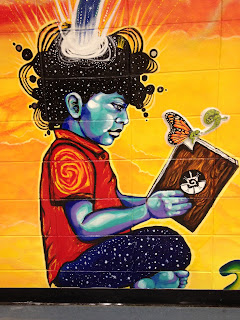This is a fantastic read from Mark Peterson at Politico on so many levels, and such fantastic news about Evanston.
"What's striking about downtown Evanston is that it's missing cars. Or, more accurately, it’s missing a lot of cars. The local automobile ownership rate is nearly half that of the surrounding area."- Mark Peterson / Redux Pictures for Politico Magazine
Excerpt:
At first glance, downtown Evanston, Illinois, doesn’t look revolutionary—just another a gentrifying urban core with the obligatory Whole Foods, the local organic sustainable restaurants serving $14 cocktails, the towering new, high-end luxury apartments filled with stainless steel appliances and granite countertops. The booming downtown feels increasingly hip; this summer it was featured as a “Surfacing” destination in the New York Times Travel Section. “I have everything here,” says Joanne McCall, pausing one evening on her way inside Sherman Plaza, a soaring, 26-story condominium building. “The post office, the dry cleaner, the movies, I work out upstairs, the Whole Foods is over there, the hair dresser over here. And the Uber thing is getting big here.”
It takes, in fact, a few extra minutes in the neighborhood to realize what’s different—and what’s missing. Downtown Evanston—a sturdy, tree-lined Victorian city wedged neatly between Lake Michigan and Chicago’s northern border—is missing cars. Or, more accurately, it’s missing a lot of cars. Thanks to concerted planning, these new developments are rising within a 10-minute walk of two rail lines and half-a-dozen bus routes. The local automobile ownership rate is nearly half that of the surrounding area.
Which again, may sound like so many other gentrifying urban areas. Who owns a car in Brooklyn, after all? But Evanston isn’t Park Slope—the city, now 75,000 strong, is quintessentially a suburb, somewhere to escape the density of nearby Chicago, a place to get extra room and, especially, a place to drive your car, jetting down Lake Shore Drive or the Edens Expressway to the Windy City. The houses in Evanston were so idyllic, in fact, that filmmakers came to use it as the beau ideal of postwar suburban life—it was where Hollywood came to film all-American suburban movies like Sixteen Candles, Dennis the Menace, Uncle Buck, and both Home Alone 2 andHome Alone 3.
And the whole point of the suburbs, reinforced by decades of local zoning laws and developers’ plans for a car-centric lifestyle, was that you weren’t supposed to live on top of your neighbor, that there was supposed to be plenty of parking everywhere you went and that you weren’t supposed to walk anywhere.
But Evanston had a different idea: What if a suburban downtown became a place where pedestrians ruled and cars were actively discouraged? As it turns out, what looks like normal urban gentrification actually marks the success of one of the most revolutionary suburbs in America. And its approach to development is fast becoming a model across the region—a model even embraced by its urban neighbor to the south, Chicago Mayor Rahm Emanuel. Evanston, Chicago and their neighbors all now want to attract more people like Tyler Hauck, 27, who pays $2,200 a month for his 1½ bedroom apartment, which he says is “definitely a high-end” building close to one of the region’s transit lines. “On the neighborhood list serve, people say things like ‘You’re paying all this money and you don’t have room for a car?’”
***
Urban density got a bad rap sometime in the mid-19th century—nobody found any redeeming value in the overcrowded Victorian slums of London—and by the beginning of the 20th century, the Englishman Ebenzer Howard’s concept of the “Garden City,” a series of outlying satellite villages to a larger, established central city, became the dogma of city planners around the world.
In the United States, the concept of density was further discredited after World War II when its antithesis—suburban subdivisions with big lots, plentiful cul-de-sacs and large connector roads to move people from home to office park to shopping mall—became not just the norm but the ideal. Aided and abetted by the construction of the federally-funded Interstate Highway System and inexpensive Federal Housing Authority loans aimed at single-family homes for returning veterans, sprawl spread across the country like a wildfire.
Public transit ridership peaked in 1956, the same year that Dwight Eisenhower signed legislation creating the Interstate Highway System, whose original 41,000 miles helped funnel the country’s shift toward suburbia.
Over time, the building practices that facilitated the classic suburban lifestyle became codified in local zoning ordinances, meant to separate commerce and residential life, and in wonky documents like the Institute of Transportation Engineers’ Parking Generation manual, which lays out a rigid ratio for the number of parking spaces required by various buildings, and has long served as the bible for developers and local officials.
The manual’s fourth and latest edition, published in 2010, includes the number of suggested parking spots for 106 separate land-use classifications, including mosques, synagogues, motorcycle dealerships, and coffee and donut shops with a drive-thru window and those without. It’s a well-meaning book, written by well-meaning people, but the assumptions and mind-set of Parking Generation and other documents like it wreaked havoc on post-war sprawl—pushing American cities ever outward, creating decades of investment in billions of dollars of ever-wider interstates, and contributing to a nation choked by car emissions and hellish traffic.
By the 1980s, even close-in American suburbs like Evanston were beginning to be hollowed out by sprawl, as their residents decamped for cheaper exurbs fueled by new shopping malls filled with big box stores.
Now, a half-century after the rise of the automobile transformed the American landscape, a new generation of urban planners is trying to reverse its dominance. “We treat our land as worthless when it’s not,” explains Yonah Freemark, pointing to a “dead” school bus sitting in a virtually empty parking lot almost directly underneath Chicago’s "L" train, as he walks along the city’s North Milwaukee Avenue.
Read more: http://www.politico.com/magazine/story/2015/10/evanston-illinois-what-works-213282#ixzz3pPYkIcV4















